Abstract
The kinematic properties of upper limb trajectories of simple reaching movements have been analysed in patients with idiopathic torsion dystonia (ITD). The velocity profiles differed from those of neurologically healthy subjects by being less symmetric. In several patients movement execution was slow due to a longer deceleration time. This phenomenon was even more conspicuous in the absence of visual feedback from the limb and was accompanied by a significant decrease in the final accuracy. These findings show that patients with ITD have deficits in central motor mechanisms beyond abnormal muscle activation patterns. Similarities between kinematic properties of patients with ITD and patients with Parkinson's disease including the deterioration of motor performance in ITD in the absence of visual feedback from the limb, suggest the existence of abnormalities in sensorimotor integration in both diseases.
Full text
PDF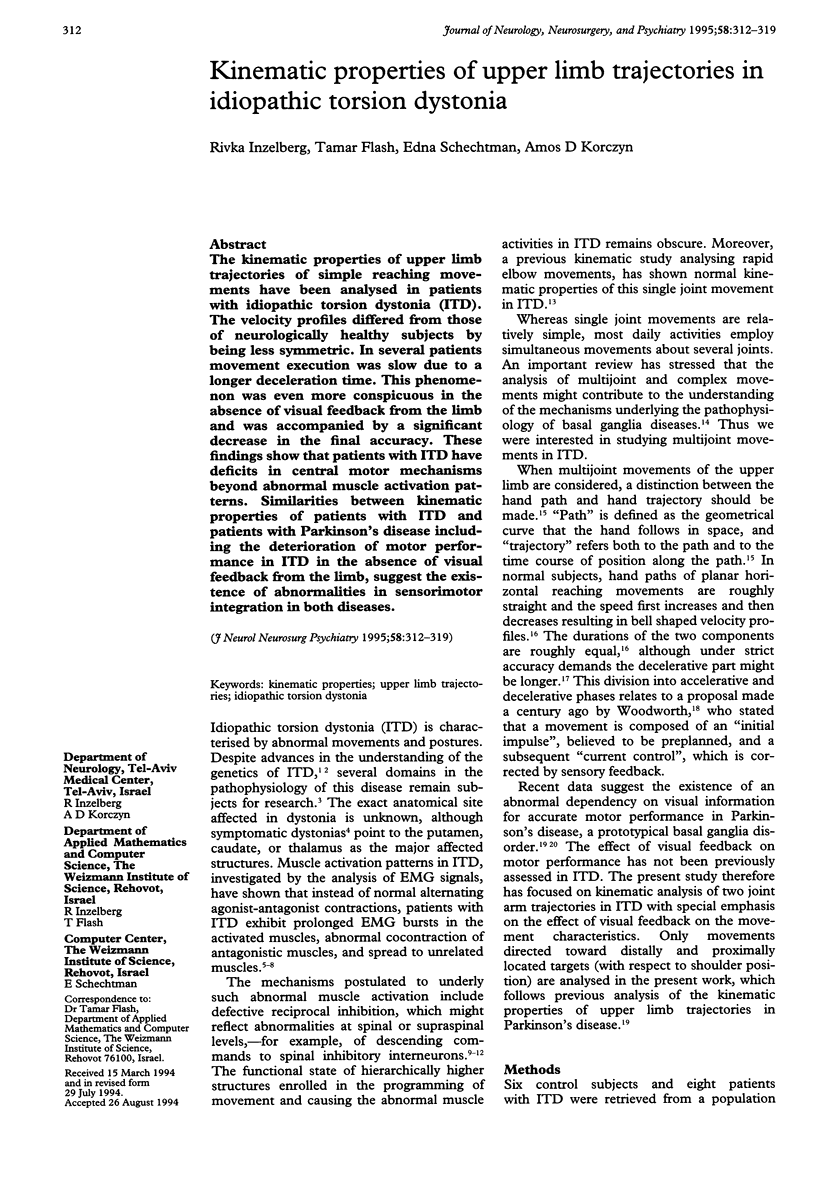
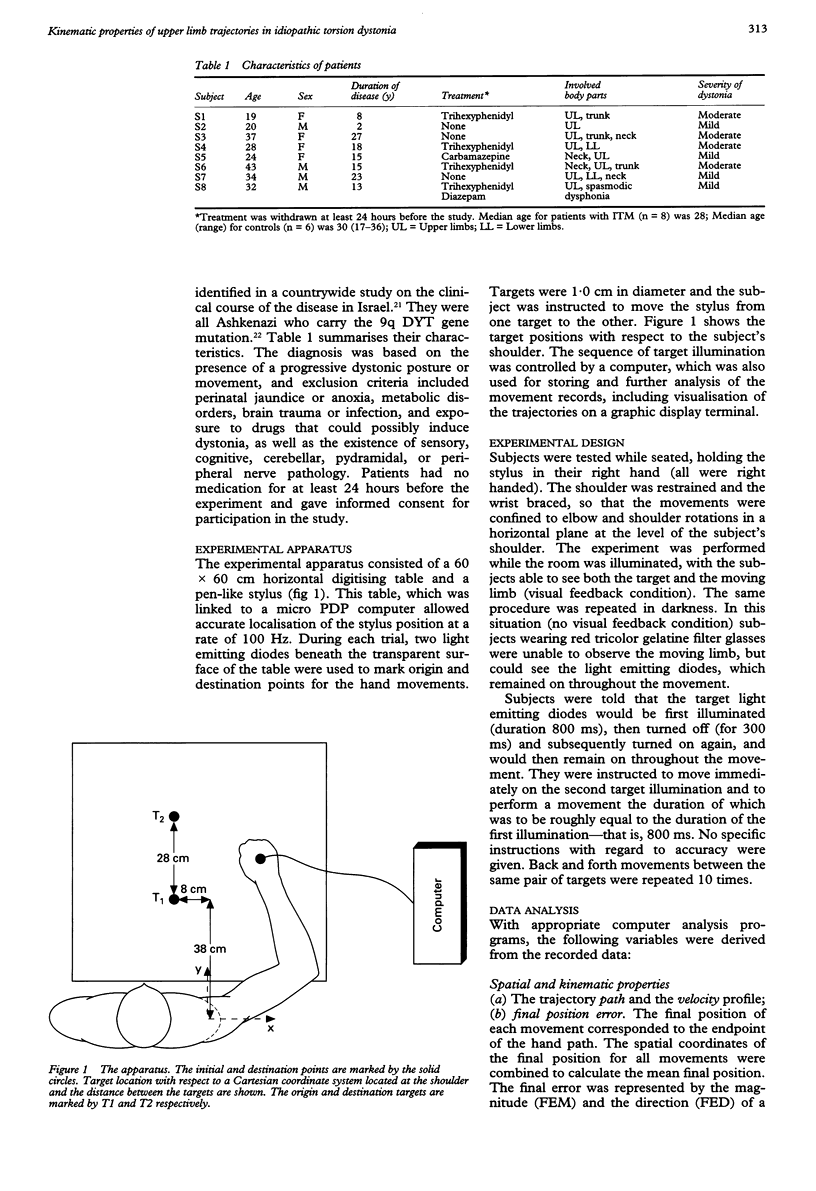
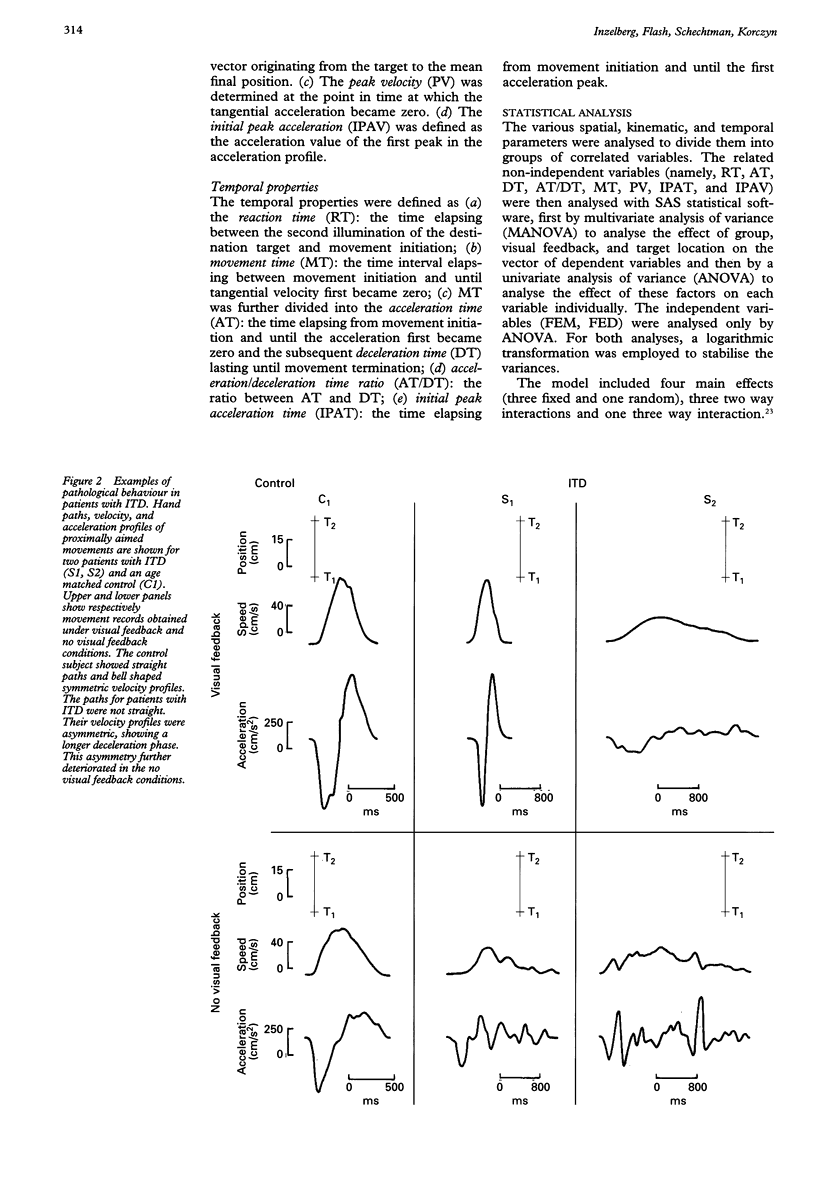
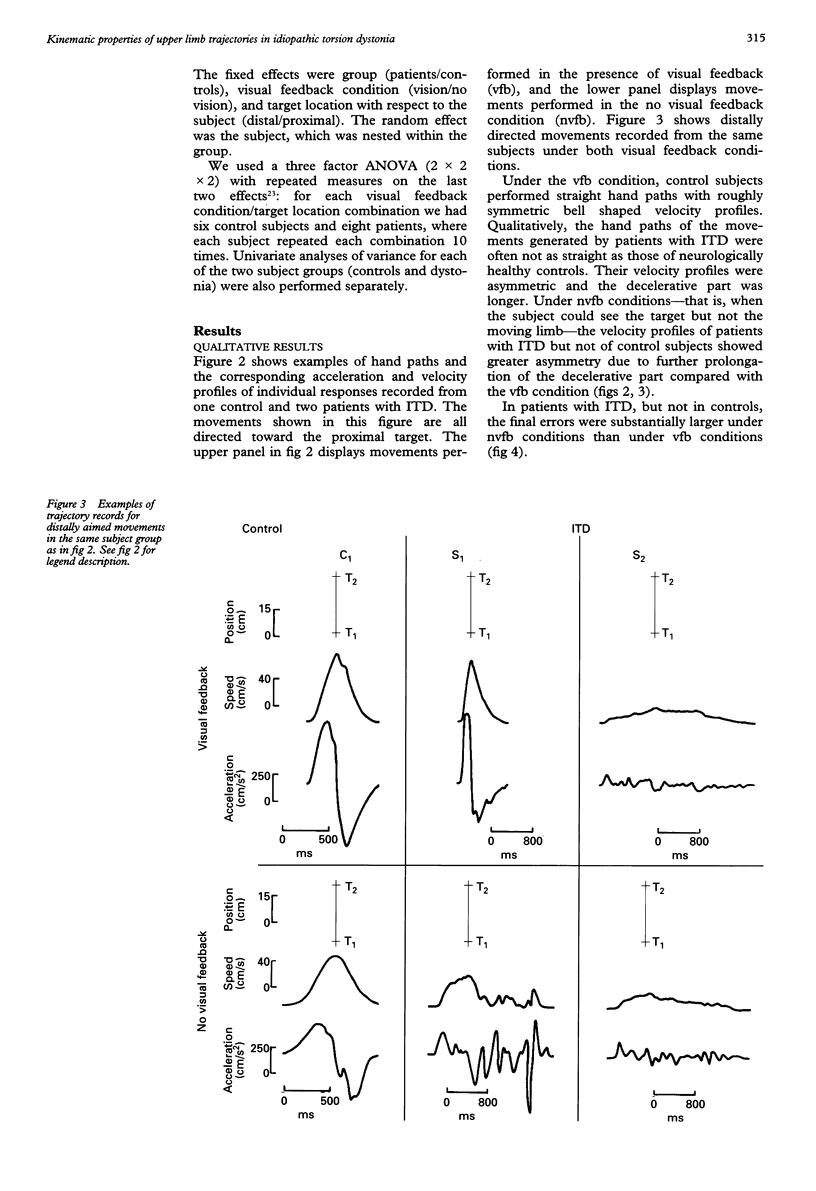
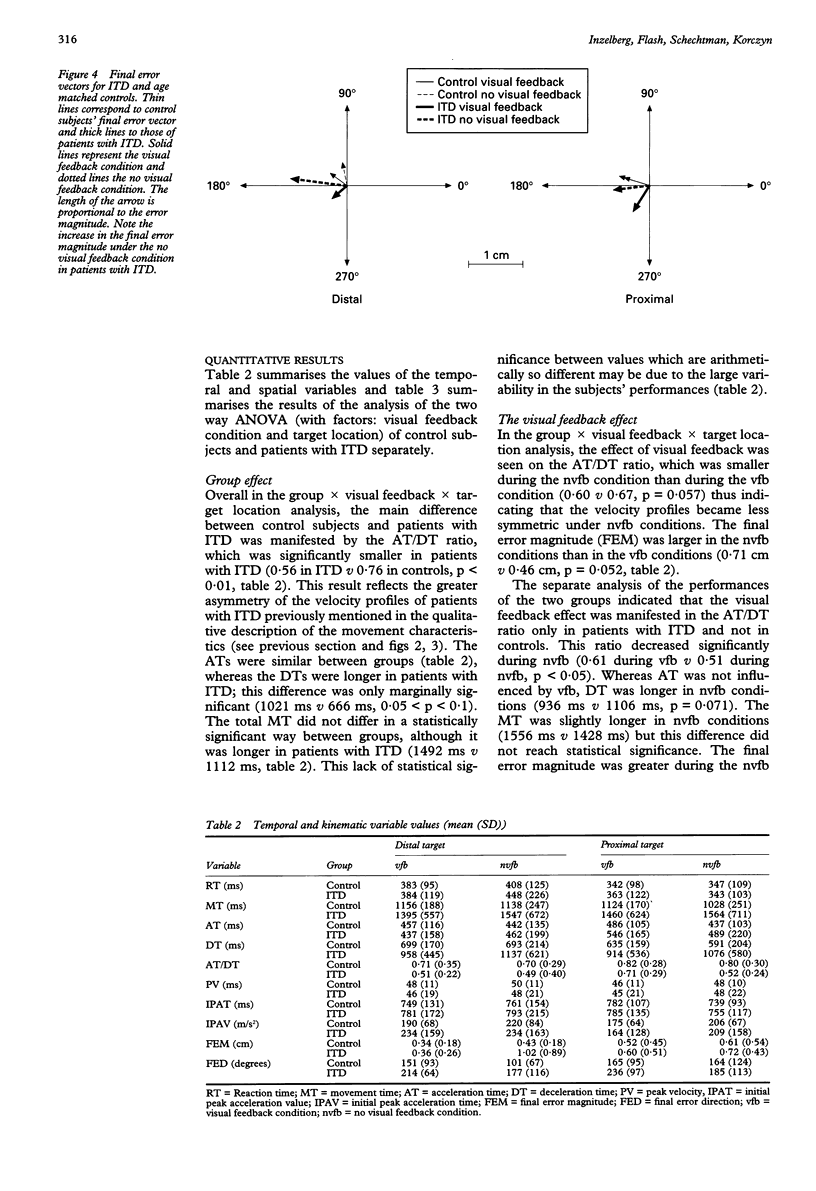
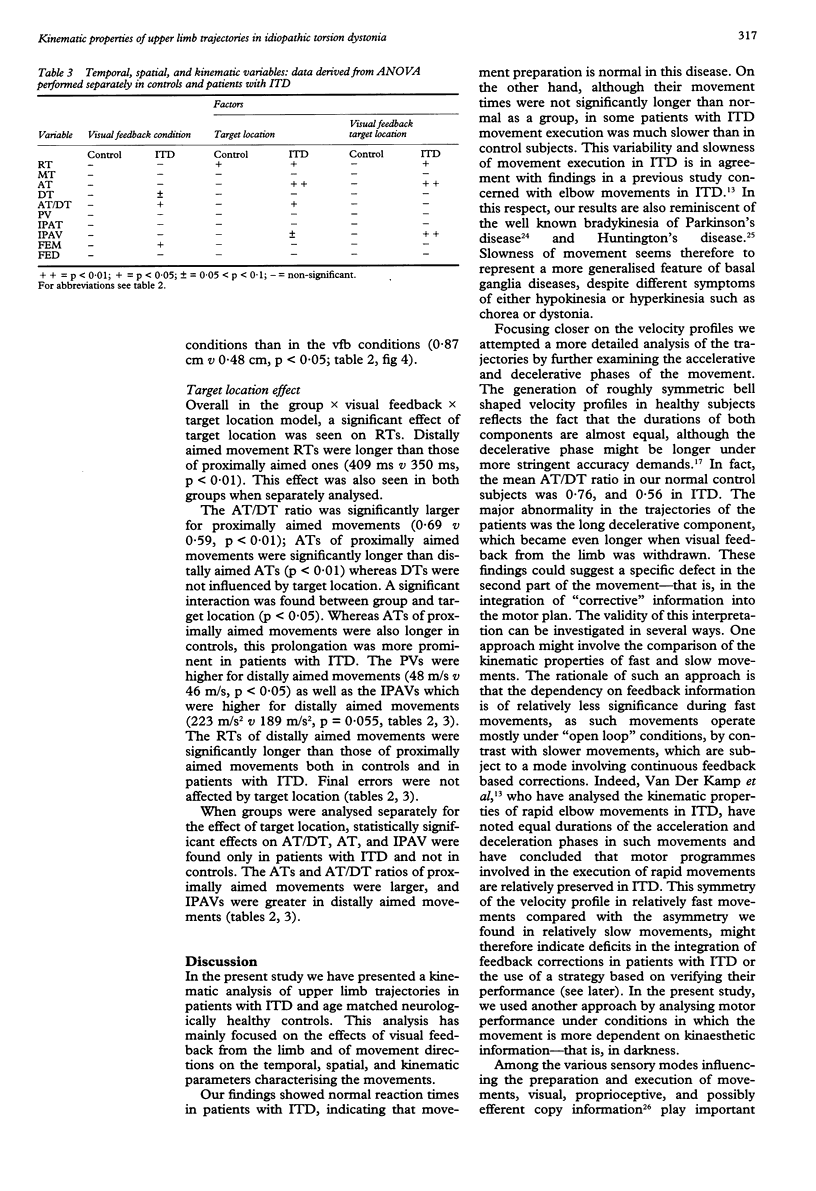
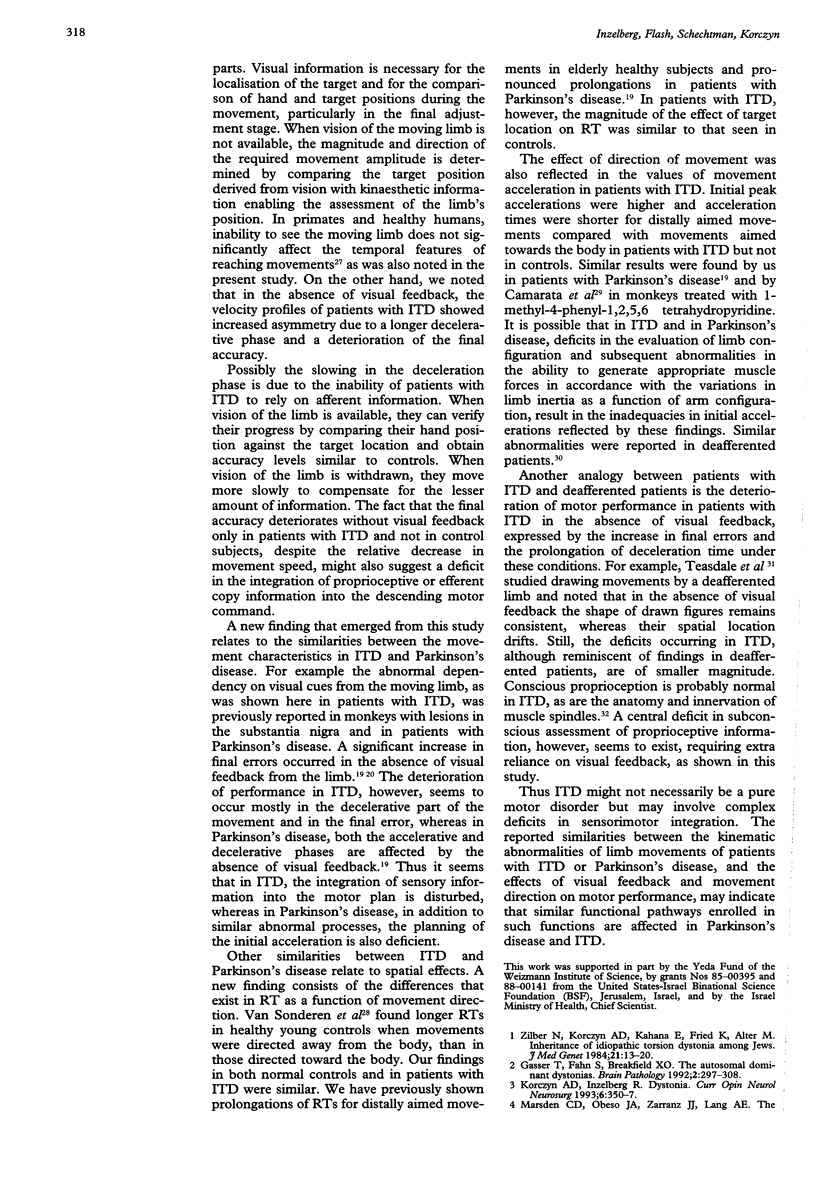
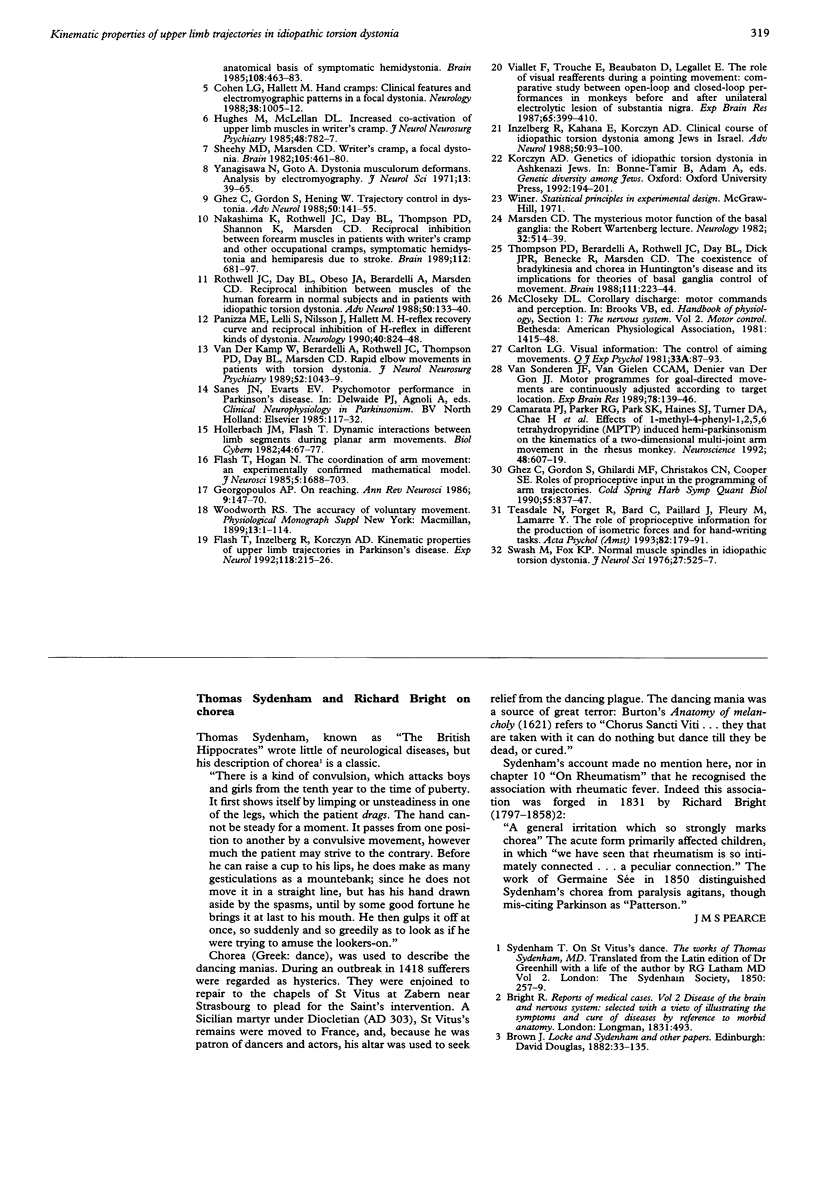
Selected References
These references are in PubMed. This may not be the complete list of references from this article.
- Camarata P. J., Parker R. G., Park S. K., Haines S. J., Turner D. A., Chae H., Ebner T. J. Effects of 1-methyl-4-phenyl-1,2,5,6-tetrahydropyridine (MPTP)-induced hemiparkinsonism on the kinematics of a two-dimensional,multijoint arm movement in the rhesus monkey. Neuroscience. 1992;48(3):607–619. doi: 10.1016/0306-4522(92)90405-q. [DOI] [PubMed] [Google Scholar]
- Cohen L. G., Hallett M. Hand cramps: clinical features and electromyographic patterns in a focal dystonia. Neurology. 1988 Jul;38(7):1005–1012. doi: 10.1212/wnl.38.7.1005. [DOI] [PubMed] [Google Scholar]
- Flash T., Hogan N. The coordination of arm movements: an experimentally confirmed mathematical model. J Neurosci. 1985 Jul;5(7):1688–1703. doi: 10.1523/JNEUROSCI.05-07-01688.1985. [DOI] [PMC free article] [PubMed] [Google Scholar]
- Flash T., Inzelberg R., Schechtman E., Korczyn A. D. Kinematic analysis of upper limb trajectories in Parkinson's disease. Exp Neurol. 1992 Nov;118(2):215–226. doi: 10.1016/0014-4886(92)90038-r. [DOI] [PubMed] [Google Scholar]
- Gasser T., Fahn S., Breakefield X. O. The autosomal dominant dystonias. Brain Pathol. 1992 Oct;2(4):297–308. doi: 10.1111/j.1750-3639.1992.tb00707.x. [DOI] [PubMed] [Google Scholar]
- Georgopoulos A. P. On reaching. Annu Rev Neurosci. 1986;9:147–170. doi: 10.1146/annurev.ne.09.030186.001051. [DOI] [PubMed] [Google Scholar]
- Ghez C., Gordon J., Ghilardi M. F., Christakos C. N., Cooper S. E. Roles of proprioceptive input in the programming of arm trajectories. Cold Spring Harb Symp Quant Biol. 1990;55:837–847. doi: 10.1101/sqb.1990.055.01.079. [DOI] [PubMed] [Google Scholar]
- Ghez C., Gordon J., Hening W. Trajectory control in dystonia. Adv Neurol. 1988;50:141–155. [PubMed] [Google Scholar]
- Hollerbach M. J., Flash T. Dynamic interactions between limb segments during planar arm movement. Biol Cybern. 1982;44(1):67–77. doi: 10.1007/BF00353957. [DOI] [PubMed] [Google Scholar]
- Hughes M., McLellan D. L. Increased co-activation of the upper limb muscles in writer's cramp. J Neurol Neurosurg Psychiatry. 1985 Aug;48(8):782–787. doi: 10.1136/jnnp.48.8.782. [DOI] [PMC free article] [PubMed] [Google Scholar]
- Inzelberg R., Kahana E., Korczyn A. D. Clinical course of idiopathic torsion dystonia among Jews in Israel. Adv Neurol. 1988;50:93–100. [PubMed] [Google Scholar]
- Korczyn A. D., Inzelberg R. Dystonia. Curr Opin Neurol Neurosurg. 1993 Jun;6(3):350–357. [PubMed] [Google Scholar]
- Marsden C. D., Obeso J. A., Zarranz J. J., Lang A. E. The anatomical basis of symptomatic hemidystonia. Brain. 1985 Jun;108(Pt 2):463–483. doi: 10.1093/brain/108.2.463. [DOI] [PubMed] [Google Scholar]
- Marsden C. D. The mysterious motor function of the basal ganglia: the Robert Wartenberg Lecture. Neurology. 1982 May;32(5):514–539. doi: 10.1212/wnl.32.5.514. [DOI] [PubMed] [Google Scholar]
- Nakashima K., Rothwell J. C., Day B. L., Thompson P. D., Shannon K., Marsden C. D. Reciprocal inhibition between forearm muscles in patients with writer's cramp and other occupational cramps, symptomatic hemidystonia and hemiparesis due to stroke. Brain. 1989 Jun;112(Pt 3):681–697. doi: 10.1093/brain/112.3.681. [DOI] [PubMed] [Google Scholar]
- Panizza M., Lelli S., Nilsson J., Hallett M. H-reflex recovery curve and reciprocal inhibition of H-reflex in different kinds of dystonia. Neurology. 1990 May;40(5):824–828. doi: 10.1212/wnl.40.5.824. [DOI] [PubMed] [Google Scholar]
- Rothwell J. C., Day B. L., Obeso J. A., Berardelli A., Marsden C. D. Reciprocal inhibition between muscles of the human forearm in normal subjects and in patients with idiopathic torsion dystonia. Adv Neurol. 1988;50:133–140. [PubMed] [Google Scholar]
- Sheehy M. P., Marsden C. D. Writers' cramp-a focal dystonia. Brain. 1982 Sep;105(Pt 3):461–480. doi: 10.1093/brain/105.3.461. [DOI] [PubMed] [Google Scholar]
- Swash M., Fox K. P. Normal muscle spindles in idiopathic torsion dystonia. J Neurol Sci. 1976 Apr;27(4):525–527. doi: 10.1016/0022-510x(76)90218-5. [DOI] [PubMed] [Google Scholar]
- Teasdale N., Forget R., Bard C., Paillard J., Fleury M., Lamarre Y. The role of proprioceptive information for the production of isometric forces and for handwriting tasks. Acta Psychol (Amst) 1993 Mar;82(1-3):179–191. doi: 10.1016/0001-6918(93)90011-f. [DOI] [PubMed] [Google Scholar]
- Thompson P. D., Berardelli A., Rothwell J. C., Day B. L., Dick J. P., Benecke R., Marsden C. D. The coexistence of bradykinesia and chorea in Huntington's disease and its implications for theories of basal ganglia control of movement. Brain. 1988 Apr;111(Pt 2):223–244. doi: 10.1093/brain/111.2.223. [DOI] [PubMed] [Google Scholar]
- Viallet F., Trouche E., Beaubaton D., Legallet E. The role of visual reafferents during a pointing movement: comparative study between open-loop and closed-loop performances in monkeys before and after unilateral electrolytic lesion of the substantia nigra. Exp Brain Res. 1987;65(2):399–410. doi: 10.1007/BF00236313. [DOI] [PubMed] [Google Scholar]
- Yanagisawa N., Goto A. Dystonia musculorum deformans. Analysis with electromyography. J Neurol Sci. 1971 May;13(1):39–65. doi: 10.1016/0022-510x(71)90206-1. [DOI] [PubMed] [Google Scholar]
- Zilber N., Korczyn A. D., Kahana E., Fried K., Alter M. Inheritance of idiopathic torsion dystonia among Jews. J Med Genet. 1984 Feb;21(1):13–20. doi: 10.1136/jmg.21.1.13. [DOI] [PMC free article] [PubMed] [Google Scholar]
- van Sonderen J. F., Gielen C. C., Denier van der Gon J. J. Motor programmes for goal-directed movements are continuously adjusted according to changes in target location. Exp Brain Res. 1989;78(1):139–146. doi: 10.1007/BF00230693. [DOI] [PubMed] [Google Scholar]
- van der Kamp W., Berardelli A., Rothwell J. C., Thompson P. D., Day B. L., Marsden C. D. Rapid elbow movements in patients with torsion dystonia. J Neurol Neurosurg Psychiatry. 1989 Sep;52(9):1043–1049. doi: 10.1136/jnnp.52.9.1043. [DOI] [PMC free article] [PubMed] [Google Scholar]


